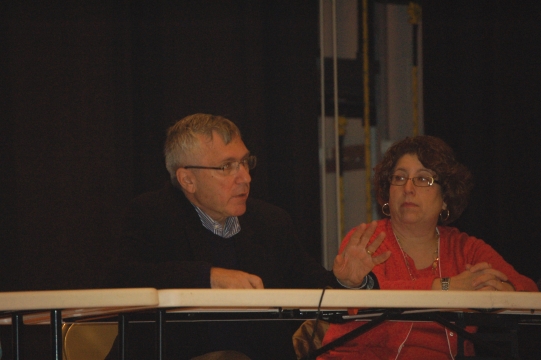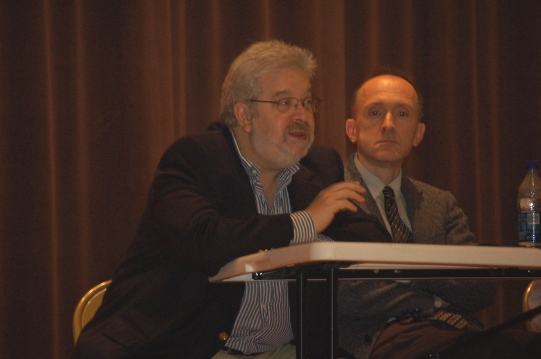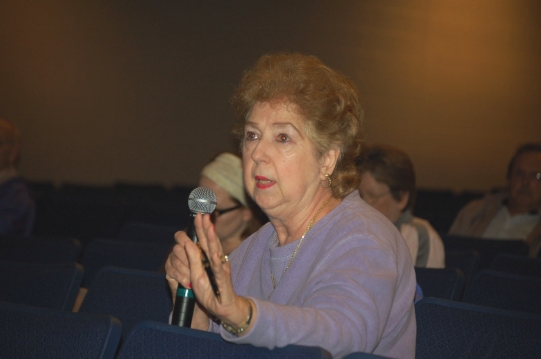2009.10.26 – Research teams unveiled
$5.5 million allocated for polycythemia vera blood disorder study
By JOE PLASKO jplasko@tnonline.com
October 26, 2009
The team of scientific researchers and investigators commissioned to study a rare blood cancer that has cropped up in the Still Creek area, has been introduced.
The federal Agency for Toxic Substances and Disease Registry (ATSDR) held a public meeting Saturday morning at the Tamaqua Area School District Auditorium to provide an update on recent efforts regarding the discovery of polycythemia vera in the tri-county area that includes Schuylkill, Carbon and Luzerne counties.
The ATSDR also announced the formation of a Community Action Committee (CAC) to serve as a link between the research groups and residents in the affected areas.
Polycythemia vera is a disorder in which the bone marrow makes too many red blood cells, sometimes referred to as “thick blood.” While polycythemia vera patients may have few or no symptoms, they may also be prone to develop blood clots and are at increased risk of a heart attack or stroke.
The disease is rare and as of yet has no known cause, but in 2005, ATSDR and the Pennsylvania Department of Health (PADOH) identified an excess of polycythemia vera cases in the tri-county region, particularly a cluster found along Ben Titus Road in Still Creek, north of Tamaqua, that was much greater than statistical instances found in the general population.
Through the efforts of U.S. Sen. Arlen Specter, $5.5 million in funding has been allocated to study the causes of the disease, which had to be assigned to research teams by last month.
A genetic marker known as JAK2 has been discovered in over 90 percent of cases of patients with polycythemia vera, although a positive JAK2 test doesn’t automatically mean a person will develop the disease.
The ATSDR, through Dr. Kenneth Orloff, has been performing blood tests for JAK2 for residents. During the first round of testing, which ran from Aug. 3-13, a total of 365 individuals were screened and notified by mail of their test results. Another 1,000 are expected to be tested during phase two of the screenings, which is currently under way and will be held through Nov. 2, with St. Jerome’s Church Hall, Tamaqua, as one of the test sites.
Vince Seaman, the ATSDR’s chief investigator on the polycythemia vera case, said the agency will wait until it gets all the numbers from the second round of testing before it releases information on the number of positive cases, although there has been some reports in the media noting that at least two new cases have been confirmed.
“Right now we only have a couple hundred individuals tested, and that’s not statistically significant,” said Seaman, who mentioned that there is the possibility of more testing. “f there are more in the cluster, we’d want to focus more in that area.”
Seaman noted the tests are very expensive to administer and would likely cost an individual between $400-$500.
“We are getting it pretty much at cost,” he said.
Seaman said researchers are examining what is the cause of the polycythemia vera cluster and is examining environmental exposures, hereditary factors and random occurrences, suggesting that it might most likely be a combination of factors.
“PV has genetic predisposition but was not previously thought to be caused by the environment,” he noted.
Additional environmental testing will be conducted and will also evaluate potentially related illnesses while continuing surveillance for polycythemia vera and other myeloproliferative diseases, Seaman said.
Research groups
Seaman said that $3.753 million of the funding has been allocated for extramural polycythemia research.
Those research groups are as follows.
The Myeoloproliferative Disorder (MPD) Research Consortium is providing a tissue bank from polycythemia vera patients. Dr. Rona Weinberg is heading the project.
Dr. Ronald Hoffman
The Mount Sinai School of Medicine will provide genetic analysis, a toxicology study and cytogenetical analysis. That project will be headed by Dr. Ron Hoffman and Dr. Ming Xu.
The Geisinger Clinic will study patterns of the case study and provide education on polycythemia vera for physicians. It will also conduct a JAK2 follow-up and a prevalence study of cases in a controlled sample in the Danville and Selinsgrove areas, to provide a comparison to the tri-county polycythemia vera cases. It will also provide a clinical outcomes study.
Dr. Paul Roda
The Geisinger group, which is also affiliated with the MPD Research Consortium, is headed by Dr. Paul Roda of the Geisinger Hazleton Cancer Clinic. One of the co-investigators is Dr. Glenn Gerhard, Lewisburg, who is a Tamaqua Area High School alumnus. Drs. Davis Carey and Porat Erlich are also part of the Geisinger investigative team.
Drexel University, Philadelphia, has been allocated $499,000 for a case control study of the tri-county cluster area. Dr. Arthur Frank is the principal investigator and Carol Ann Gross-Davis is serving as the project manager.
Additionally, the Pa. Department of Health is continuing with MPD surveillance in the area and is working on a comparison study of polycythemia vera through the University of Pittsburgh.
The Pa. Department of Environmental Protection (DEP) will continue to examine potential environmental causes, particularly the McAdoo Associates Superfund site located not far from the Still Creek Cluster, as well as conducting residential testing.
Dr. Henry Cole
The funding also provides for the formation of the Community Action Committee, which will be coordinated by Dr. Henry Cole of H. Cole and Associates. Joe Murphy of Hometown, who has been involved with working with state and federal agencies on these health issues, will be the local representative.
ATSDR is also receiving $1.746 million of intramural funding, which will go toward an exposure investigative team, improving the Center for Disease Control (CDC) national registry reporting of MPDs, environmental and geospatial analysis, technical support and oversight of the research groups.
Public comment
Violet Skibiel of Minersville attended the meeting and said she had polycythemia vera, which was diagnosed and treated through Geisinger.
“I never dreamed I had this rare disease,” said Skibiel, whose husband Ed said he has leukemia. “What caused my PV? What corrupted my gene?”
Roda said Skibiel should ask for a tissue sample to be sent to Weinberg for the tissue bank. Such a sample would include a blood test, toenail clippings and possibly bone marrow.
Dr. Peter Baddick, a Tamaqua area physician who has been involved with polycythemia vera cases, asked if the late Betty Kester, who had the disease, would have her tissue samples at Geisinger. He also wondered if the funding would be adequate to get to the bottom of the issue.
Seaman said posthumous samples could be part of the tissue bank.
Hoffman, a leading expert on PV, said it is difficult to identify one specific compound in the environment that might cause the disease.
“Prior to our identification of this site, we never viewed the environment as the cause of this disease,” said Hoffman. “This area, unfortunately, is a laboratory for polycythemia vera.” Hoffman said that if such a compound would be identified as a cause, a chemical-related cure would also be sought if possible.
He also said the overwhelming majority of patients with MPDs did not inherit them.
“It is rare that families are diagnosed,” he added, although he noted three or four husband-wife teams diagnosed in the New York City area. He added that there are 300 families diagnosed with multigenerational cases, many of them in Europe.
Pat Tracey
“I don’t think it’s hereditary,” said Pat Tracy, a resident who said she is a melanoma survivor. “It’s from everybody dumping their garbage in our area (a reference to the Eastern Diversified Metal and McAdoo Superfund sites). I think it will show up in our children.”
Seaman said the ATSDR is well aware of the “environmental insults” to the area and will take that into account in the research.
Roseann Johnson, who lives in Still Creek, expressed frustration with the process.
“I know nothing more now than I knew before,” she said. “Where are the answers?”
Dr. Cole, an atmospheric scientist and air quality control specialist coordinating the CAC, acknowledged that aspect.
“You’ve been dealing with this for a long time, while I am stepping into this now,” he stated.
Cole said the CAC will hold its first meeting on Wednesday, Oct. 28 at 7:30 p.m. at the Hometown Fire Company.
The public session was attended by state Rep. Jerry Knowles (R-124) and representatives of state Sen. David Argall (R-29) and U.S. Congressman Timothy Holden of St. Clair.
“This is certainly what we’ve asked for and wanted,” said Knowles of the research groups. “I can sense the frustration of people, but we have $5.5 million to get started. Science does not go quickly, so it’s going to take some time. I feel we’re on the right direction to providing answers to difficult questions.”




